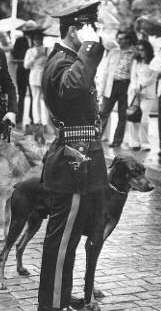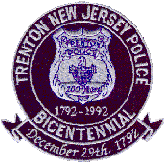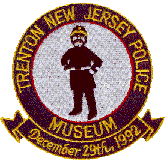TRENTON POLICE MUSEUM

1940 - 1959

Historic Synopsis
1940ís
The 1940ís marked the end of the Great Depression and economic recovery began. America breathed a sigh of relief and looked forward to better times after the lean years of the 1930ís. All this changed on Sunday, December 7, 1941, when America found itself thrust into World War II. On the days following the bombing of Pearl Harbor, tensions ran high on both coasts. The West coast prepared for an invasion by Japan, while on the east coast there were increased reports of German Submarine activities. Men of fighting age enlisted in the armed services by the thousands and the country banded together for the struggle ahead. Terms like "Civil Defense" ,"Black Out", "Air Raid" and "Rationing" became household words. Cities and towns everywhere established Civil Defense units. With the majority of the young men off fighting in the war, Trenton Police Department witnessed an aging of the force. The Department now had the added duties of enforcing Civil Defense procedures. Ensuring "Black Outs" and "Air Raid" drills were adhered to.
|
Order of Chief William A. Dooling
December 8, 1941
As Chief of Police I will expect every man of the department to lend his whole hearted and unbending cooperation in the performance of his duties as defender and protector of civilians during this grave emergency.
|
|
With the allied victory in Europe and then in the Pacific, came national jubilance and the men returning from the war found the economy high. War time production was shifted back to items of convenience and new births were on the rise. Technology developed during the war, such as RADAR and portable radios, would later find its way into the Police service. In 1949, the position of Deputy Chief was created.
|

1950ís
The economic growth which had begun in the 1940ís continued to prosper. The largest indication of this growth was reflected in the Police Salaries. The Chiefís salary would swell from $5,600 a year, to $9,200. In todayís economy the shift in pay may not seem to be much, however between 1929 and 1950 the Chiefís annual salary only saw an increase of $1,200. The department also recognized the need to better reflect the community in its ranks and the hiring of African Americans began to rise. Though these men were only a small portion of the department, it was a step in the right direction.
|
Salary Comparisons
* No Pay Raises for 16 years
| RANK |
1929-45* |
1950 |
1959 |
|---|
| Chief |
$4,400 |
$5,600 |
$9,020 |
| Dep. Chief |
N/A |
$4,900 |
$8,020 |
| Captain |
$3,600 |
$4,600 |
$6,900 |
| Lieutenant |
N/A |
$3,900 |
$6,200 |
| Sergeant |
$2,650 |
$3,750 |
$5,700 |
| Patrolman |
$2,400 |
$3,400 |
$5,300 |

Gallery

| First Precinct, Headquarters |
|---|
| circa 1940 |
|
Officers stand for roll call at the front of the First Precinct on Chancery Lane. |

| Police Communion Breakfast |
|---|
| circa WWII |
|
A section of a very large photograph, taken during a Communion breakfast. Because of the absence of younger officers, this photo is believed to have been taken during World War II.
|

| First District Traffic Officers |
|---|
| circa 1940
|

| Police Motor Cycle |
|---|
| mid 1940's |
|
Officer Fred Sigafoos on a department tricycle, stops in the rear of the New Jersey State House. Unlike the two wheeled motorcycles, these were able to be used when snow was on the roads.
|

| Police Motor Cycle |
|---|
| mid 1940's |
|
Officer Fred Sigafoos with the more traditional two wheel motorcycle.
|

| Patrolman John R. Prihoda |
|---|
| 1947 |
|
Hired in 1947 and assigned to the Second Precinct, Prihoda began his career as a Foot Cop. After 23 years with the department he was promoted to Chief in 1970. Chief Prihoda retired in 1990, and his 20 year tenure as Chief of Police is the longest in the history of the department.
|

| Detectives |
|---|
| circa 1950 |
|
Trenton Detectives inspect a cache of guns at the First Precinct. Present is a uniformed New Jersey State Trooper.
|

| Radio Room |
|---|
| early 1950's |
|
Dispatchers sit at the "state of the art" radio console. With the amount of Radio Patrol cars increasing, dispatching was now a two man job.
|

| PBA Basketball Team |
|---|
| early 1950's |
|
(back row, L-R) |
John McKeever, Anthony Micharski, George Ecker,
Edward Franks, Richard Jachetti, John Sullivan,
Richard Bossman, Roland PerFeri
|
|---|
| (front row, L-R) |
William Mullen, George Malone, Frank McDermott,
John Prihoda, Jim McDonough
|
|---|

| Radio Patrol Car |
|---|
| circa 1953 |
|
MAKE: Ford YEAR: 1952-54 Car number 11
|

| African American Officers |
|---|
| June 23, 1957 |
|
(back row, L-R) |
Quntillious Smith, Robert O'Neal, Johnie W. Sapp,
Lester Young,
William Winston, John Purdy
|
|---|
| (front row, L-R) |
Lone Hodges, Ronald Whortenberry, Marvin Holmes,
Theopolius Baker, Leon Smith
|
|---|

Table of Contents
[ MUSEUM HOME PAGE |
DEPARTMENT HOME PAGE ]
Persons have ANY materials relating to the history of the
Trenton Police Department, are requested to Click Here.
Direct questions or comments to historian@tpdhistory.com
©1997, 1998, 1999, 2000, 2001, 2002, 2003 by M. Crosby Click here for more copyright information Click here for more copyright information
|












